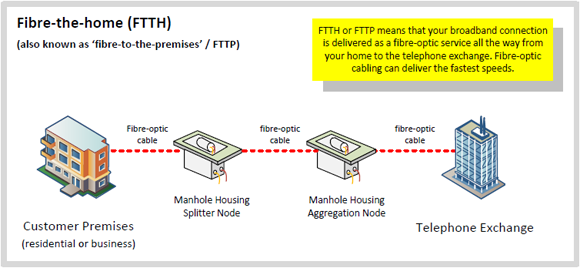- Related articles
- Things you need to know about integrated network card
- All Cisco X2-10GB-LRM's information (List price, Specs, Datasheet PDF, Compatibility matri
- What is Overhead Fiber Optic Cable?
- All Cisco CWDM-SFP10G-1470's information (List price, Specs, Datasheet PDF, Compatibility
- All Cisco DS-CWDM4G1550's information (List price, Specs, Datasheet PDF, Compatibility mat
- What is 1Gb Network Card?
- Application of Fiber Optic Cable
- Optical Transceivers for Cisco WS-C2960S-F48LPS-L Switch
- Do You Really know About Fiber Optic Cable?
- How to Find What Ethernet Controller Card I'm using?

1. Uplink and downlink
ADSL (Asymmetric Digital Subscriber Loop) technology is a kind of technology that uses an asymmetric digital subscriber line to achieve broadband access to the Internet. ADSL as a technology of transmitting layer, takes full advantage of existing copper wire resources, offers the bandwidth of uplink at 640kbps (theoretically at 1Mbps ) and downlink at 8Mbps on a twisted-pair, thus to overcome the “bottleneck” of traditional users at “ the last kilometer”, and accomplish the broadband access in truth.
 application.png)
Uplink rate generally refers to the rate at which data is transmitted to the server, and downlink rate refers to the rate at which data is downloaded from the server. For ADSL networking which is applied in the ordinary broadband, the uplink rate and downlink rate are not symmetrical; generally, downlink rate is higher than uplink rate, mostly the uplink rate is 386Kb and downlink rate is 512Kb.
Note: the rate is not equal to the actual speed you will have, you need to divide the rate by 8, then you will almost get the actual speed. Therefore, in above case the actual speed is around 50k.
For the fiber optic broadband, it is based on the optical fiber cable which contains 2 fibers at least, one fiber is for uplink transmission, and another is for downlink data transmission.
The benefits that fiber optic broadband brings:
a. Because it involves the passive network, there is almost no power supply needed between the center office and users end.
b. Fiber optic broadband is based on the optical fibers, so the network can be free of many problems like interference, electricity and so on.
c. Due to the large bandwidth, the supportive agreement is more flexible.
d. Relatively perfect performance for the future development or expansion.

2. Routing
In the fiber optic transmission system, less medium equipment are required, so less links in the whole system, relatively there is lower possible of breakdowns, and transmitting data to the backbone network is faster. Besides, the broadband of fiber optic network is far higher than that of ADSL network.
3. Technical comparison
(1) Technical development
ADSL technology is a good filtration technology, while fiber optic technology is seriously a real broadband technology, which is better than ADSL.
(2) Target customers
ADSL is suitable for decentralized users, while FTTx + LAN based on fiber optic broadband is for the relatively concentrated users group.
(3) Popularity & customers awareness
ADSL is the well-known product in the broadband market. While most of the consumers just have increasing awareness and expectations of the LAN.
(4) Cost and price
One of the advantages for fiber optic broadband is the low-cost hubs, Ethernet switch and other networking devices, and users do not need to install ADSL modems, which require users less investment and cheap cost. While ADSL is not free of fixed telephone and limited by geographical restrictions due to using the center office of existing city telephone network and telephone exchange room; besides, the telephone cost also increases the investment for users.
(5) Speed
ADSL is an asymmetric digital technology which causes asymmetric uplink rate and downlink rate and the network speed is limited, the maximum is 8M; therefore, ADSL is not going to satisfy the demands for access rate in the future market. While LAN adopts the symmetric digital broadband technology which is equipped with higher and developing bandwidth, the network speed it supports up to over 150M.
(6) Stability & anti-interference
ADSL has an unstable line performance. The higher the transmission rate gets, the greater the influence on signals made by attenuation and interference is.
While FTTx community broadband adopts the network different from telephone network, all the connections of fiber optic broadband are based on optical fibers which make the network high stability and reliability.
(7) Access method
ADSL uses telephone twisted-pair as the access method for ordinary network. While fiber optic broadband access to users end uses fiber optic cables, plug and play, this is a better security for the lines performances.
(8) Business & function
ADSL can support Internet / Extranet / Intranet business, voice services, video services, ATM services, data services, frame relay FR access services, VPN virtual private network services, and can accomplish interconnection, information sharing, mutual visits and delivery between networks.
The fiber optic broadband covers all the business and functions of ordinary network. It helps to build intelligent community broadband network system, to form a whole local area network involving the home terminal and property management platform for supporting the property management to offering various types of online value-added services.
Conclusion
Fiber optic broadband and ordinary broadband both are widely used now all over the world, but fiber optic broadband is gradually replacing the traditional broadband method on account of its obvious advantages and the ever-increasing demands for bandwidth and network performance. The differences between them can be clearly learned from this article so that you will have a better choice to pick a proper network. No matter which is your demand, there is definitely a solution to accomplish it in Cozlink.





















































